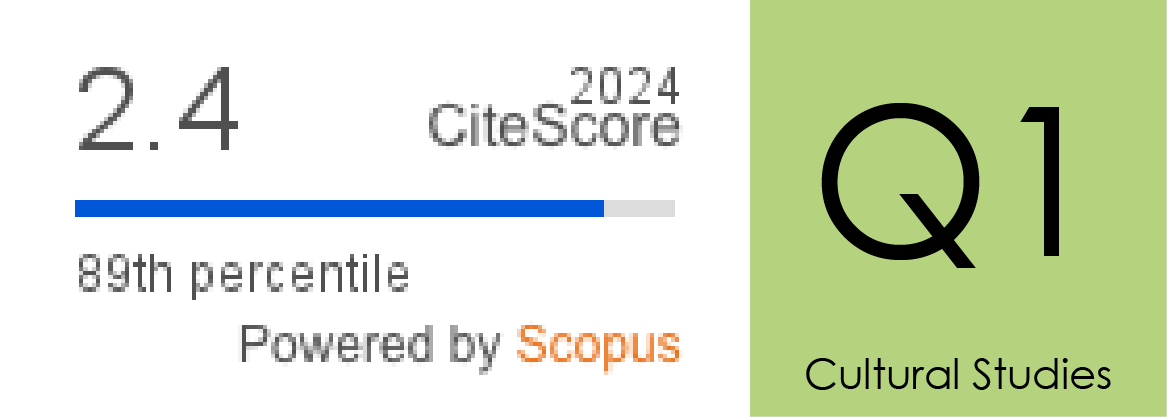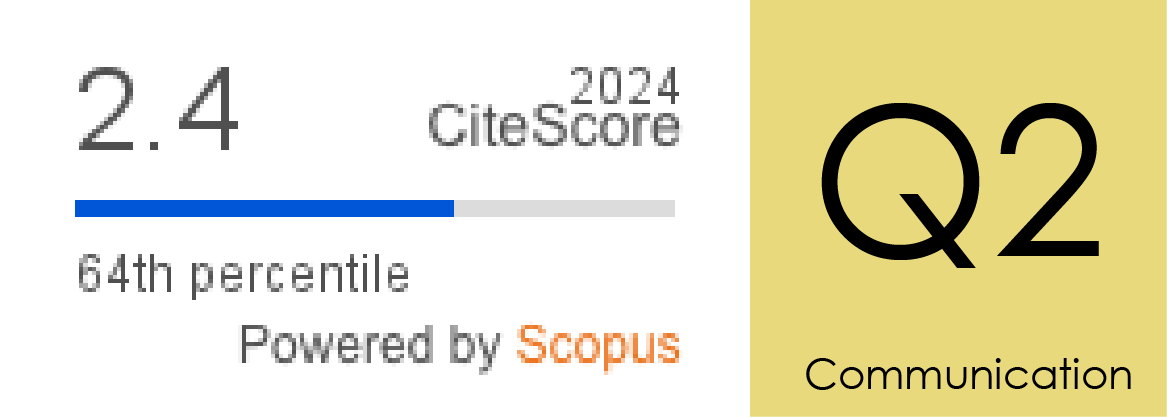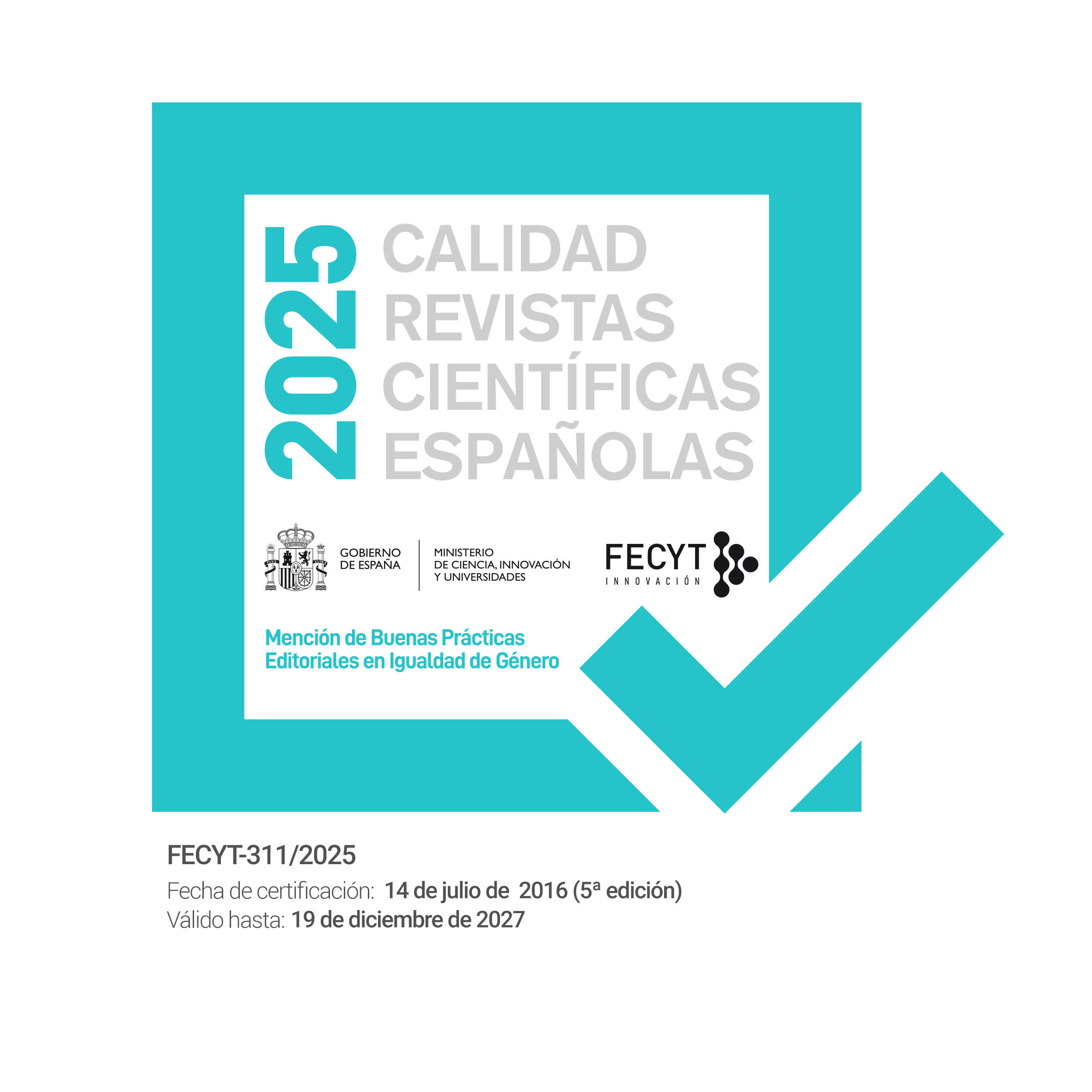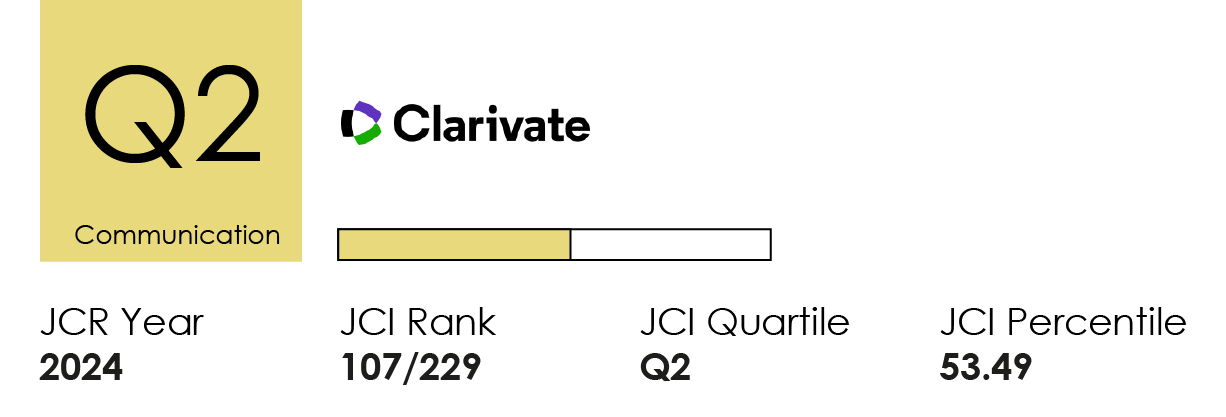Metaanálisis del consumo digital en el ecosistema mediático contemporáneo: factores distintivos e implicaciones emocionales
DOI:
https://doi.org/10.14198/MEDCOM2017.8.1.6Palabras clave:
Internet, Consumo mediático, Periodismo, Sociedad red, Tecnología, Usuarios, MetaanálisisResumen
Dos de los elementos característicos de la sociedad contemporánea son la sobreabundancia de información y la velocidad de las comunicaciones, desarrolladas en un escenario marcado por la hiperconectividad de las personas. Este uso intensivo de la tecnología despierta emociones en los usuarios y sirve además como cauce para la expresión de sus afectos. Con todo ello, el objetivo de este artículo de corte teórico es doble. Por un lado, identificar y presentar los rasgos distintivos del consumo digital en el ecosistema mediático actual. Por otro, describir las implicaciones que dicho consumo tiene en la dimensión emocional de las personas. Entre las conclusiones aportadas se destaca la conveniencia de que el usuario digital desarrolle un consumo mediático crítico y consciente, al que va asociado una necesaria gestión de las emociones.Financiación
Ministerio de Economía y Competitividad y el Fondo Europeo de Desarrollo Regional (FEDER) con expediente CSO2015-64662-C4-1-R MINECO/FEDER, UECitas
Andrejevic, M. (2013). Infoglut: How Too Much Information Is Changing the Way We Think and Know. London: Routledge.
Ash, J. (2015). Sensation, Network, and the GIF: Toward an Allotropic Account of Affect. En HILLIS, K., PAASONEN, S. y PETIT, M. (Eds), Networked Affect (pp. 119-113). Cambridge, MA: The MIT Press.
Barranquero-Carretero, A. (2013). Slow media. Comunicación, cambio social y sostenibilidad en la era del torrente mediático. Palabra Clave, vol. 16, nº 2, 419-448.
Batson, C.; Shaw, L. y Oleson, K. (1992). Differentiating affect, mood, and emotion: Toward functionally based conceptual distinctions. Personality and Social Psychology Review, 13, 294–326.
Brod, C. (1984). Technostress: The Human Cost of the Computer Revolution. Reading: Addison Wesley.
Carr, N. (2010). The Shallows: What the Internet Is Doing to Our Brains. New York: W. W. Norton & Company.
Caro Castaño, L. (2016). Microcelebridades y comunicación encubierta online en España. El caso de #Pentatrillones. adComunica. Revista Científica de Estrategias, Tendencias e Innovación en Comunicación, 11, 121-144.
Castells, M. (2009). Communication power. Oxford: Oxford University Press.
Castells, M. (1997). La era de la información. Economía, sociedad y cultura. Vol 1: La sociedad red. Madrid: Alianza.
Cornella, A. (2008). Principio de la infoxicación. En FERNÁNDEZ GARCÍA, J. J., Más allá de Google (pp. 19-22). Barcelona: Infonomía.
Crawford, M. (2015). The World Beyond Your Head: How to Flourish in an Age of Distraction. New York: Viking Press.
Dafonte, A. (2014). Claves de la publicidad viral: De la motivación a la emoción en los vídeos más compartidos. Comunicar, 43, pp. 199-207. http://dx.doi.org/10.3916/C43-2014-20
Davenport, T. H. y Beck, J. C. (2001). The Attention Economy: Understanding the New Currency of Business. Cambridge, MA: Harvard Business School Press.
Del Vicario, M., Bessi, A., Zollo, F., Petroni, F., Scala, A., Caldarelli, G. et al. (2016). The spreading of misinformation online. Proceedings of the National Academy of Sciences, 113(3), 554–559. Disponible en: http://goo.gl/29CvSO
Deuze, M. (2012). Media Life. Cambridge: Polity Press.
Días, P. y Jorge, A. (2016). Audience experiencing of emotions in the contemporary media landscape. Participations. Journal of Audience & Reception Studies, vol 13, issue 1, 431-445.
Días, P. y Teixeira-Botelho, I. (2014). Is the Second Screen becoming the First? An exploratory study of emerging multi-screening practices. Proceedings of the International Conference on Computer Graphics, Visualization, Computer Vision and Image Processing. Lisboa, 15-19 Julio.
Díaz Arias, R. (2015). Curaduría periodística, una forma de reconstruir el espacio público. Estudios sobre el Mensaje Periodístico, 21 (nº especial diciembre), 61-80. http://dx.doi.org/10.5209/rev_ESMP.2015.v21.51129
Díaz-Nosty, B. (2013). La prensa en el nuevo ecosistema informativo. ¡Que paren las rotativas!. Barcelona: Ariel-Fundación Telefónica.
Doughty, M., Rowland, D., y Lawson, S. (2012). Who is on your sofa?: TV audience communities and second screening social networks. Proceedings of the 10th European conference on Interactive TV and video—EuroiTV (pp. 79–86). New York: Association for Computing Machinery.
Doval, M. (2012). Por una dieta informativa más variada y sana. Aceprensa, 10 de abril de 2012. Disponible en http://goo.gl/PQAZON
Döveling, K., Von Scheve, C., y Konijn, E. (eds.) (2010). The Routledge Handbook of Emotions and Mass Media. London: Routledge.
Eckler, P., y Bolls, P. (2011). Spreading the Virus: Emotional Tone of Viral Advertising and its Effect on Forwarding Intention and Attitudes. Journal of Interactive Advertising, 11(2), 1-11. http://dx.doi.org/10.1080/15252019.2011.10722180
Ferrés, J. (2014). Las pantallas y el cerebro emocional. Barcelona: Gedisa.
Fortunati, L. y Vincent, J. (2009). Introduction. En J. VINCENT y L. FORTUNATI (eds.), Electronic Emotion. The Mediation of Emotion via Information and Communication Technologies (pp. 1-31). Bern: Peter Lang.
García Avilés, J.A. (2016): “La información ya no es lo que era”. Diez propuestas sobre el periodismo en la Sociedad Red. Revista de la Asociación Española de Investigación de la Comunicación, 3(5), 1-8. Disponible en http://goo.gl/Vo6LgT
Garde-Hansen, J. y Gorton, K. (2013). Emotion Online. Theorizing Affect on the Internet. Basingstoke: Palgrave Macmillan.
Giglietto, F. y Selva, D. (2014). Second Screen and Participation: A Content Analysis on a Full Season Dataset of Tweets. Journal of Communication, 64, 260–277. http://dx.doi.org/10.1111/jcom.12085
Gitlin, T. (2003). Media Unlimited: How the Torrent of Images and Sounds Overwhelms Our Lives. New York: Henry Holt and Company.
Gleick, J. (2011). The Information: A History, A Theory, A Flood. London: Harper Collins.
Goldhaber, M. (1997). The Attention Economy and the Net. First Monday, vol. 2, nº 4-7 April. Disponible en http://goo.gl/z9dGw5
Goleman, D. (2013). Focus: The Hidden Driver of Excellence. New York: Harper Collins.
González, A. M. (2013a). The recovery of emotion in philosophy and social sciences. Conferencia en la Università Cattolica del Sacro Cuore (Scuola di Dottorato in Scienze Sociali). Milán (Italia), 3 de mayo.
González, A. M. (2013b). Introducción: emociones y análisis social. En FLAMARIQUE, L. y D’OLIVEIRA-MARTINS, M. (Eds.), Emociones y estilos de vida: radiografía de nuestro tiempo (pp. 9-24). Madrid: Biblioteca Nueva.
Grusin, R. (2010). Premediation: Affect and Mediality after 9/11. Basingstoke: Palgrave Macmillan.
Han, B.-C. (2015). El aroma del tiempo: un ensayo filosófico sobre el arte de demorarse. Barcelona: Herder.
Han, B.-C. (2012). La sociedad del cansancio. Barcelona: Herder.
Harvey, D. (1998). La condición de la postmodernidad. Investigación sobre los orígenes del cambio cultural. Buenos Aires: Amorrortu.
Hermida, A. (2014). Tell Everyone. Why We Share & Why It Matters. Toronto: Doubleday Canada.
Hochschild, A. R. (1979). Emotion work, feeling rules and social structure. The American Journal of Sociology, 85, 551-575. Disponible en http://goo.gl/DF7Sc4
Honoré, C. (2012). Elogio de la lentitud. Uno movimiento mundial desafía el culto a la velocidad. Barcelona: RBA.
Jarrett, K. (2015). “Let’s Express Our Friendship by Sending Each Other Funny Links instead of Actually Talking”: Gifts, Commodities, and Social Reproduction in Facebook. En HILLIS, K., PAASONEN, S. y PETIT, M. (Eds), Networked Affect (pp. 203-219). Cambridge, MA: The MIT Press.
Jenkins, H. (2008). Convergence Culture. La cultura de la convergencia de los medios de comunicación. Barcelona: Paidós.
Klapp, O. E. (1986). Overload and boredom: essays on the quality of life in the information society. New York: Greenwood Press.
Lasén, A. (2010). Mobile Media and Affectivity: Some Thoughts about the notion of Affective Bandwidth. En HÖFLICH, J. R. et al. (Eds.), Mobile Media and the Change of Everyday Life (pp. 131-154). Frankfurt am Main: Peter Lang.
Le Masurier, M. (2016). Slow Journalism. Digital Journalism, 4(4), 405-413. http://dx.doi.org/10.1080/21670811.2016.1139904
Lewis, M., Havilland-Jones, J. y Feldman Barret, L. (eds.) (2008). Handbook of Emotions (3ª edición). New York: The Guilford Press.
Lucchetti, S. (2010). The Principle of Relevance. The Essential Strategy to Navigate Through the Information Age. Hong Kong: RT Publishing.
Martín Algarra, M., Torregrosa M. y Serrano-Puche, J. (2013). Un periodismo sin períodos: actualidad y tiempo en la era digital. En GARCÍA, A. (Coord), Periodística y web 2.0: hacia la construcción de un nuevo modelo (pp. 73-83). Estudios de Periodística XVII. Madrid: CEU Ediciones.
Martín Barbero, J. (2008). Políticas de la comunicación y la cultura: Claves de la investigación. En: Documentos del CIDOB. Serie Dinámicas interculturales, 11, Barcelona: Fundación CIDOB.
Miller, D. (2008). New Media, Networking and Phatic Culture. Convergence: The International Journal of Research into New Media Technologies, 14(4), 387-400.
Nielsen (2014). The digital consumer. Disponible en http://goo.gl/Lk1c7z
Papacharissi, Z. (2014). Toward New Journalism(s). Affective News, Hybridity, and liminal Spaces. Journalism Studies, 16(1), 27-40. http://dx.doi.org/10.1080/1461670X.2014.890328
Parisier, E. (2011). The Filter Bubble: What The Internet Is Hiding From You. New York: The Penguin Press.
Rainie, L. y Wellman, B. (2012). Networked. The New Social Operating System. Cambridge, MA: The MIT Press.
Reig, D. (2013). Describiendo al hiperindividuo, el nuevo individuo conectado. En Reig, D. y Vílchez, L. Los jóvenes en la era de la hiperconectividad: tendencias, claves y miradas (pp. 23-90). Madrid: Fundación Telefónica.
Reuters Business Information (1996). Dying for information: an investigation into the effects of information overload in the UK and worldwide. London: Reuters.
Rodríguez, D. (2013). Memecracia. Los virales que nos gobiernan. Barcelona: Gestión 2000.
Rushkoff, D. (2013). Present Shock. When Everything Happens Now. New York: The Penguin Group.
Serrano-Puche, J. (2015). Emotions and Digital Technologies: Mapping the Field of Research in Media Studies. MEDIA@LSE Working Paper Series, 33. Disponible en http://goo.gl/8C31DK
Serrano-Puche, J. (2013). Una propuesta de dieta digital: repensando el consumo mediático en la era de la hiperconectividad. Fonseca Journal of Communication, 7 (Julio-Diciembre), 156-175.
Shenk, D. (1997). Data Smog: surviving the information glut. New York: Harper Collins.
Shifman, L. (2013). Memes in digital culture. Cambridge: The MIT Press.
Shirky, C. (2010). It’s not Information Overload. It’s Filter Failure. Mas Context, issue 7 (‘Information’), Fall, 76-85. Disponible en http://goo.gl/4xFChi
Smith, A. y Boyles, J. L. (2012). The rise of the ‘connected viewer’. Pew Internet & American Life Project, Pew Research. Disponible en http://goo.gl/J6gfMn
Spitzberg, B. H. (2014). Toward a Model of Meme Diffusion (M3D). Communication Theory, 24, 311–339. http://dx.doi.org/10.1111/comt.12042
Svensson, J. (2014). Power, Identity, and Feelings in Digital Late Modernity: The Rationality of Reflexive Emotion Displays Online. En Benski, T. y Fisher, E. (Eds.), Internet and Emotions (pp. 17-32). New York: Routledge.
Toffler, A. (1970). Future Shock. New York: Random House.
Trejo Delarbre, R. (2006). Viviendo en el Aleph. La Sociedad de la Información y sus laberintos. Barcelona: Gedisa.
Turner, J.H., y Stets, J.E. (Eds.) (2007). Handbook of the Sociology of Emotions. New York: Springer.
Virilio, P. (2012). La administración del miedo. Madrid: Pasos Perdidos-Barataria.
Wahl-Jorgensen, K. (2013). Emotional architecture of social media: The Facebook ‘Like’ button. Paper presented at the 63rd Annual Conference of the International Communication Association (ICA), London (UK), 17-21 de junio.
Wajcman, J. (2015). Pressed for Time. The Acceleration of Life in Digital Capitalism. Chicago: The University of Chicago Press.
Weinberger, D. (2012). Too Big to Know. New York: Basic Books.
Wurman, R. (1989). Information Anxiety. New York: Doubleday.
Descargas
Estadísticas
Publicado
Cómo citar
Número
Sección
Licencia
Derechos de autor 2017 Javier Serrano-Puche

Esta obra está bajo una licencia internacional Creative Commons Atribución-CompartirIgual 4.0.
Los autores y autoras que publican en esta revista están de acuerdo con los siguientes términos:
1 Derechos de autor. Los autores y autoras conservan sus derechos de autor, aunque ceden a la revista de forma no exclusiva los derechos de explotación (reproducción, distribución, comunicación pública y transformación) y garantizan a esta el derecho de primera publicación de su trabajo, el cual estará simultáneamente sujeto a la licencia indicada en punto 2. Los autores pueden establecer otros acuerdos adicionales para la distribución no exclusiva de la versión de la obra publicada en la revista, siempre que exista un reconocimiento de su publicación inicial en esta revista.
© Los autores.
2 Licencia. Los trabajos se publican en la revista sujetos a la licencia de Reconocimiento 4.0 Internacional de Creative Commons (CC BY 4.0); los términos se pueden consultar en https://creativecommons.org/licenses/by/4.0/
Esta licencia permite a terceros compartir (copiar y redistribuir el material en cualquier medio o formato) y adaptar (remezclar, transformar y crear a partir del material para cualquier finalidad, incluso comercial), siempre que se reconozca la autoría y la primera publicación en esta revista (Revista Mediterránea de Comunicación (RMC) / Mediterranean Journal of Communication (MJC), Universidad de Alicante, DOI de la obra), se proporcione un enlace a la licencia y se indique si se han realizado cambios en la obra.
3 Política de autoarchivo. Se recomienda a los autores que difundan sus trabajos a través de Internet para favorecer una circulación y difusión más rápidas y, con ello, un posible aumento en la citación y alcance entre la comunidad científica y académica, en las siguientes condiciones:
No se permite a los autores depositar en un repositorio institucional o temático, página web propia, etc., las versiones preprint (versión antes de ser evaluada) o postprint (versión evaluada y aceptada para su publicación) de sus trabajos antes de su publicación, pero sí el artículo final publicado (versión del editor).













